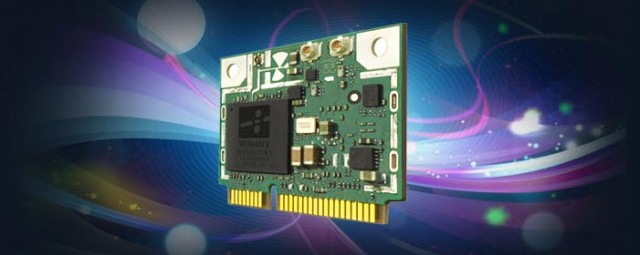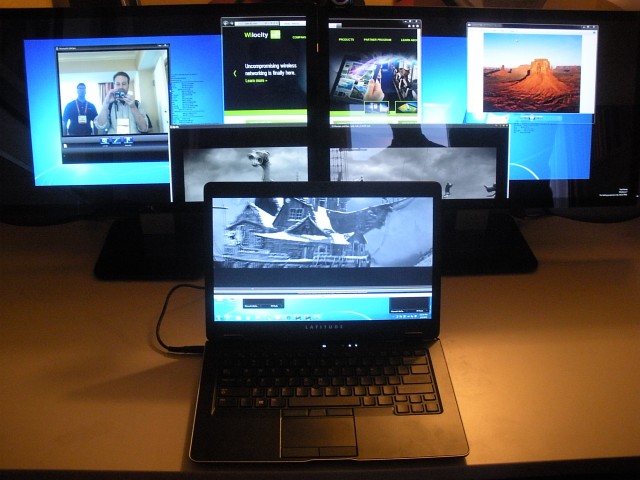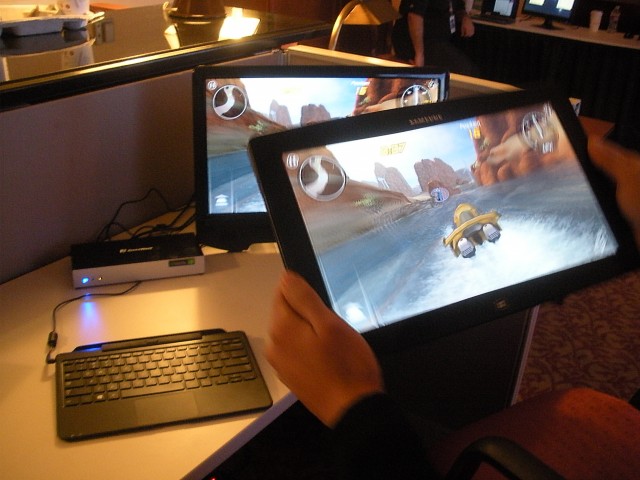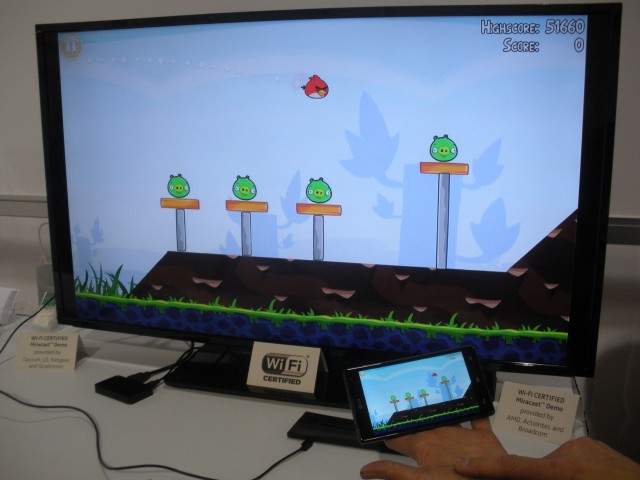
Wilocity's wireless chips allow 4.6Gbps transmission over the 60GHz band.
On one desk, a laptop powered a two-monitor setup without any wires. At another, a tablet playing an accelerometer-based racing game mirrors its screen in high definition to another monitor. Across the room, a computer quickly transfers a 3GB file from a wireless router with built-in storage.In a quiet suite removed from the insanity of the Consumer Electronics Show expo floor, a company aiming to build the fastest Wi-Fi chips in the world demonstrated its vision of wireless technology's future.
The suite was set up in the Las Vegas Hotel byWilocity, a chip company specializing in wireless products using 60GHz transmissions, which are far faster than traditional Wi-Fi. Avoiding the show floor is a good idea if you're worried about Internet connectivity, because thousands of vendors are clogging the pipes. But that's not why Wilocity was here—they'd be able to perform the demo even in the busiest parts of CES without interference because they're not relying on the congested bands used by regular Wi-Fi.
"I don't think we'd have an issue with air congestion," said director of product marketing Teresa Liou. "We're just here because it's quieter and less hectic than being on the show floor."
Faster than a speeding bullet, too weak to pass through walls
Traditional Wi-Fi using the 2.4GHz and 5GHz bands is crossing the gigabit per second mark with the 802.11ac standard. Wilocity is one of the main proponents of the even faster WiGig (or "wireless gigabit"), which can theoretically hit speeds of up to 7Gbps, with the downside of using frequencies that are easily blocked by walls. Even thin cubicle walls may block signals, Wilocity acknowledged. (See: 7Gbps wireless transfers and streaming, no router required.)
It's possible the next wireless router you buy will use the 60GHz frequency as well as the lower ones typically used in Wi-Fi, allowing for incredibly fast performance when you're within the same room as the router and normal performance when you're in a different room.
Wilocity's current chips hit a maximum throughput of 4.6Gbps, putting wireless speeds roughly on par with USB 3.0. Tri-band routers, wireless storage devices, and docking stations that facilitate wireless connections between mobile devices and monitors were all showcased in the Wilocity suite. These were just prototype devices, since shipping products have mostly not yet hit the market.
A Dell Latitude 6430u Ultrabook is thus far the only product using a Wilocity chip that you can buy. But WiGig isn't really a selling point for this laptop today, because there's no way to take advantage of it until there are companion products like docking stations or routers. Liou said Dell is planning a bundle to pair the Ultrabook with another WiGig-enabled product, but otherwise Wilocity couldn't say when further products will hit the market.
WiGig builds on top of the just-completed 802.11ad wireless standard. Wilocity's first-generation chip with 802.11ad can be used in computers and docking stations that connect devices to monitors, keyboards, and mice, but the chip can't be used in wireless routers. A second-generation chip with router support was announced by Wilocity and Qualcomm at CES this week. The chip combines 802.11ad with 802.11ac, the successor to 11n. That way, when WiGig products have to fall back to 2.4GHz or 5GHz transmissions, they'll at least be getting the best speeds that regular Wi-Fi offers. The chip will be sampled to vendors within a few months, and Wilocity is working with Marvell on tri-band chips as well, Liou noted.
Since no tablets with a WiGig chip are commercially available, Wilocity installed one of its chips into a Samsung Windows 8 tablet for purposes of the demo. The routers, wireless storage devices, and docking stations shown off by Wilocity were also prototypes made in conjunction with original design manufacturers like AzureWave.
Wilocity wanted to dispel any notion that WiGig requires users to keep devices stationary because of the limitations in 60GHz frequencies. To do that, they demonstrated streaming video from a laptop to a monitor while spinning the laptop around in circles. WiGig compensates for the movement with beamforming technology, which helps direct wireless signals.
"It finds the best path every time. It reflects off the walls," Wilocity hardware engineer Vineeth Alva said.

An Ultrabook powering two monitors, wirelessly through WiGig.

Wilocity's Teresa Liou plays a game on a tablet, which is mirrored onto the monitor through the docking station on the left.
At the same time, walls are real obstacles to those 60GHz waves. When devices are in range, WiGig can enable every type of use case that regular Wi-Fi can, including connecting to the Internet, but falls back to slower 2.4GHz or 5GHz transmissions when the 60GHz connection is broken.
Wilocity had routers with network-attached storage placed strategically on the ceiling to allow a good path to WiGig-enabled devices. In one demo, a Wilocity engineer transferred a 3GB file from the NAS to a computer at rates of 1.2Gbps. That's slower than the theoretical peak of Wilocity chips—Alva blamed the application layer and perhaps hardware bottlenecks unrelated to the chip itself. Still, it's fast, and the file transfer zoomed ceaselessly toward completion when in range of the router. But when the engineer stepped around a corner, the transfer fell back to normal Wi-Fi and slowed to a crawl.
With wireless docking, tablets become PCs
Wilocity isn't alone in pitching WiGig. Back on the CES expo floor, Ars spoke with Ali Sadri, president and chairmen of the Wireless Gigabit Alliance industry group. Sadri's job there may soon come to an end, as the consortium is in the process of merging with the Wi-Fi Alliance, bringing WiGig into the same group that handles all the general Wi-Fi certification programs. The merger helps legitimize WiGig, so Sadri says if his role does come to an end he'll count it as a victory. In any case, he has a day job at Intel as director of millimeter wave standards (anything above 30GHz).
Sadri couldn't reveal anything about Intel's plans for WiGig chips, saying only "If Intel is behind something normally they are involved in some development as well." One of the top use cases for WiGig will be turning tablets into full-fledged PCs, Sadri argued. Touch-optimized devices can now run a full PC operating system (aka Windows 8) but are limited in both storage and the ability to dock with a mouse, keyboard, and monitor, he noted. WiGig-enabled storage devices and docking stations solve both of those problems. The tablet connects to a docking station, and the docking station is connected to a monitor and peripherals via HDMI.
"In a couple of years I don't think there will be a difference between a tablet and a PC with WiGig," he said.
WiGig can "replace practically any cable and connector," performing every type of Wi-Fi use case even while multiplying the speed of Wi-Fi, he said. "It's almost like a Switzerland that, you know, here's a technology and see what you can do. … I cannot imagine in two years what is going to be out there. I wish I could extrapolate."
WiGig is based on two specifications. The 802.11ad standard developed at the IEEE standards group forms the base of it, while the WiGig spec itself adds protocol adaptation layers (PALs) to interface with audio-visual and input/output systems. The Wireless Gigabit Alliance is finishing up version 1.2 of the WiGig spec, and then will hand over development to the Wi-Fi Alliance.
Success will depend on hardware makers, of course. USB adapters could extend WiGig capability to laptops or even tablets with a USB port, but to achieve the truly mobile use cases Sadri described the chips will need to be pre-installed in tablets by manufacturers.
Don't forget Miracast and 802.11ac
Even though WiGig isn't yet widely available, Wi-Fi is marching on with new capabilities. 802.11ac routers were introduced by several companies at CES, and a new streaming technology called Miracast was demoed by various companies including AMD, Broadcom, Cavium, Netgear, and Qualcomm.
Miracast, as we've written, lets phones, tablets, or laptops stream to monitors over the 5GHz band. Today it runs over 802.11n but is being adapted to run over 802.11ac as well. Miracast, which is much like Apple's AirPlay, is already built into such phones as the LG Optimus and Samsung Galaxy S3. At CES, Wi-Fi Alliance Marketing Director Kelly Davis-Felner showed me a demo of the LG phone streaming to a TV through a Netgear Push2TV adapter, which can bring Miracast capability even to TVs without built-in Wi-Fi. If you want to play Angry Birds on a large monitor, this is the way to do it:

The Wi-Fi Alliance uses an LG Optimus to demonstrate Miracast, a standard that lets mobile devices stream to TVs.
The Wi-Fi Alliance has certified about 260 devices to run Miracast, 60 of which have been publicly announced. Nearly half of those are TVs, the rest split between phones, tablets, and adapters, Davis-Felner said.
802.11ac routers you can buy today have not yet been certified to ensure interoperability with other devices, because the Wi-Fi Alliance will only begin certifying 802.11ac devices around April. Still, the spec is stable and well-known enough that incompatibility between devices probably won't be a problem. Certification of 802.11ad products will probably start at the end of 2013, she said.
Miracast is definitely useful and has the advantage of actually being available to consumers today, but Sadri said it can't replace what WiGig is trying to do with the 60GHz band. "If I'm streaming a video if I have even a second delay, who cares," he said. "But when I'm in front of a computer and I'm typing a Word document or doing some drawings, any small artifact is going to show."
The Miracast demo Davis-Felner showed me worked fine on the crowded show floor. There's a small amount of lag that can be detected in the above Angry Birds photo, but I didn't notice it in real time. Sadri, though, scoffs at today's Wi-Fi technology, saying only WiGig will provide "cable-equivalent quality of service."
"Good luck getting any Wi-Fi network operating at CES," he said.
No comments:
Post a Comment
Let us know your Thoughts and ideas!
Your comment will be deleted if you
Spam , Adv. Or use of bad language!
Try not to! And thank for visiting and for the comment
Keep visiting and spread and share our post !!
Sharing is a kind way of caring!! Thanks again!